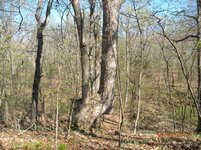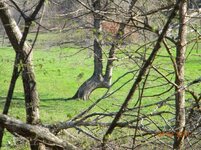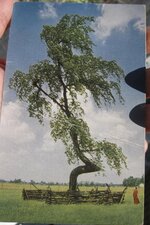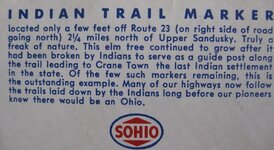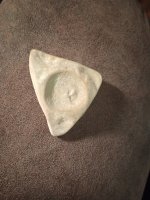You are using an out of date browser. It may not display this or other websites correctly.
You should upgrade or use an alternative browser.
You should upgrade or use an alternative browser.
Indian Trail Trees....more info...
- Thread starter archer66
- Start date
archer66
Sr. Member
- Thread starter
- #4
Thanks everyone...I found more info. Here is a website dedicated to "collecting" these trees:
http://www.mountainstewards.org/project/internal_index.html
And here is a short article:
http://www.time.com/time/magazine/article/0,9171,790217,00.html
During turkey season this year I am going to try to get a picture of all of them on our place and mark gps coordinates of each one. Then I'll post to coordinates on a map and see if there is any obvious route marked or not.
http://www.mountainstewards.org/project/internal_index.html
And here is a short article:
http://www.time.com/time/magazine/article/0,9171,790217,00.html
During turkey season this year I am going to try to get a picture of all of them on our place and mark gps coordinates of each one. Then I'll post to coordinates on a map and see if there is any obvious route marked or not.
fasttracker
Jr. Member
- Sep 19, 2008
- 50
- 5
I think i've read a post like this before, the only problem I see with this is that those trees look to be 100 years old tops. And it'd take like 20 years before it would become a prominent marker so you would think they'd have easier ways to mark a trail back then but I really dont know 

- Jan 27, 2009
- 18,714
- 11,690
- 🥇 Banner finds
- 1
- Detector(s) used
-
Tesoro Conquistador freq shift
Fisher F75
Garrett AT-Pro
Garet carrot
Neodymium magnets
5' Probe
- Primary Interest:
- All Treasure Hunting
fasttracker said:I think i've read a post like this before, the only problem I see with this is that those trees look to be 100 years old tops. And it'd take like 20 years before it would become a prominent marker so you would think they'd have easier ways to mark a trail back then but I really dont know
Archer
I really doubt it... I work with a bunch of forresters and we have discussed this many times. Most trees and oaks in particular are not old enough. Some can be though as we aged one at around 400 years old looking for the oldest Oak in Ga. Its base was the size of a VW. My point is this. I have a pic of a small oak in my yard in 1927. A very small tree. The oak blythe got it this last year and I had to cut it down, It had grown to be a monster in size since 1927. That being said the tree you are showing in my opinion could not be old enough to have been bent by the Indians. They also talk about eagles being carved and so forth. I am kinda skeptical on this. I carved a Giant smooth bark elm about 30 years ago with our names and you can still read them but the odds of it lasting say 200 years is slim but plausable I guess.
Also you bend a tree and it gets any size it will fracture in the bend for sure. I have read this stuff on sites before but I remain a skeptic, The tree you are showing in my opinion is around 40 years old and was damaged or trapped and bent over by another tree when young.
Hey I have been wrong before

- Jan 27, 2009
- 18,714
- 11,690
- 🥇 Banner finds
- 1
- Detector(s) used
-
Tesoro Conquistador freq shift
Fisher F75
Garrett AT-Pro
Garet carrot
Neodymium magnets
5' Probe
- Primary Interest:
- All Treasure Hunting
The links show the majotity of the trees are in my area. We have wind shears that will rip out strips of trees in the forrest and moutains The sapplings are all bent over from the debri and then start growing straight up and the debri rots away leaving you a lot of trees in the paths of the wind shears trapped and bent and now have sunlight and shoot straight up real fast. Right now we have about 4 places the wind stripped out clearings. Makes great hunting the next season though for bow cause it routes the animals around..
Later
TnMtns
Later
TnMtns
Jonzer
Hero Member
- Feb 12, 2010
- 541
- 55
- Detector(s) used
- Natural Eyeball Pressure
- Primary Interest:
- All Treasure Hunting
I agree with TN, probably just blown over.
However, There is a procedure called "tie down" for fruit trees where you rope and stake the central leader of a sapling, bending the tree over. This causes several central leaders to to be produced which grow straight up. Once the tree is trained, the horizontal branches are removed.
However, There is a procedure called "tie down" for fruit trees where you rope and stake the central leader of a sapling, bending the tree over. This causes several central leaders to to be produced which grow straight up. Once the tree is trained, the horizontal branches are removed.
GroundS.KeepeR
Hero Member
Are them trees even that old? 

GroundS.KeepeR
Hero Member
Here's a old one in the town i live in..
http://travel.webshots.com/photo/2229197220017353410IUHfJq
http://travel.webshots.com/photo/2229197220017353410IUHfJq
lostlake88
Hero Member
Hi,
Those trees are not old enough, but they do resemble Indian marker/boundry trees. Whites also did this (learning from natives) before fencing. There are legit sources of info on this (lyman Draper in particular), but just brief accounts. Eckert mentioned them in his books quite abit.
Those trees are not old enough, but they do resemble Indian marker/boundry trees. Whites also did this (learning from natives) before fencing. There are legit sources of info on this (lyman Draper in particular), but just brief accounts. Eckert mentioned them in his books quite abit.
GroundS.KeepeR
Hero Member
Cool.. Thanks for the info..lostlake88 said:Hi,
Those trees are not old enough, but they do resemble Indian marker/boundry trees. Whites also did this (learning from natives) before fencing. There are legit sources of info on this (lyman Draper in particular), but just brief accounts. Eckert mentioned them in his books quite abit.
Lone Star
Sr. Member
- Jan 6, 2010
- 384
- 428
- Detector(s) used
- Garrett Ace 400
- Primary Interest:
- All Treasure Hunting
Flinty ones, The trees themselves arn't old enough no doubt. However groupings of nut trees of any kind can be indicitive of past habitation due to the collection and storage of nuts as a food source. This is evident in my own experience, as well as from two retired road engineers I've known. As these fellas built roads along the rural Texas and La. coastal plains, groupings of oak trees (oak motts) stood out on the grassy plain. Every one of them had pottery,bone and related indian debris amongst the normal white man trash. It is theorized that as the nuts were collected some fell by the wayside (like the points we search for) and with the added nutrients of the cooking fires gradually developed into more dense groupings. The bends and weird growth patterns attest for natural thinning and regeneration occurances due to storms, blight, etc., as they adapt to survive and propagate. So, there is a certain validity to the term "indian trees" and it depends on circumstance and coincidence.
Groove on ya'll, G.
Groove on ya'll, G.
archer66
Sr. Member
- Thread starter
- #15
Thanks for the info folks...I have no way of knowing how those trees got bent the way they are but it is interesting to think about. I know for sure that you are wrong about the ages of the trees pictured....how you ask? Well my dad is 66 and he grew up on that farm, he was born in a log home in 1943 about 500 yards from where the pictures above were taken. He said those trees were huge when he was a teenager. He and my uncles built a small fort around the base of the one in the pasture.....kind of a lean to deal made of logs. That piece of property actually belongs to a neighbor and the "fort" is gone now....back then there were no fences. The pasture where that tree sits was pasture in the 1950's and probably way before that. I suppose the tree could have been pinned by something but I don't know what it would have been as its been all by itself in that field for at least 60 years. Some time I'll go measure the trunks on a few of those trees but they are ginormous to say the least. I know they aren't 1000 years old but was figuring they could be 100-200 years old....which may be pushing it in longevity but would put them into an era when the area was being settled and natives were causing trouble. I did some research on the area and found out that there is a salt spring nearby. In 1799, a settler established a salt business a few miles west of a local town.....this farm happens to be a few miles west of said town. Sauk and Fox Indians threatened his safety, and his salt processing works were abandoned after a short period.
Anyway....I respect everyone's opinions and logic says that you may well be right...they are just natural occurrences. The possibility exists that they were bent that way by local indians or by white men.....who knows...it is fun to think about it and wonder though.

Anyway....I respect everyone's opinions and logic says that you may well be right...they are just natural occurrences. The possibility exists that they were bent that way by local indians or by white men.....who knows...it is fun to think about it and wonder though.
- Jan 27, 2009
- 18,714
- 11,690
- 🥇 Banner finds
- 1
- Detector(s) used
-
Tesoro Conquistador freq shift
Fisher F75
Garrett AT-Pro
Garet carrot
Neodymium magnets
5' Probe
- Primary Interest:
- All Treasure Hunting
I can imagine them tying them in knots and all sorts of stuff. I have no doubt that they did that. I have been reading and called a guy,lol. Ok in 30-40 years you can cut Timber again. A oaks (white oak)average age 300 years some examples are believed to be 800 years old with one cut in 1964 they thought was 5000 years old. Soooo,, what kinda oak do you have? Looks like anything may be possible Archer. You hunt so I bet you know your oak species.
TnMtns
TnMtns
lostlake88
Hero Member
I knew I had an old postcard to show you guys. The post card is probably from the 40's-50's, the elm may be 130 years old putting us back to 1820 or so. And yes there were hold out Indian towns during that time in the area in Ohio.
Attachments
archer66
Sr. Member
- Thread starter
- #18
TnMountains said:I can imagine them tying them in knots and all sorts of stuff. I have no doubt that they did that. I have been reading and called a guy,lol. Ok in 30-40 years you can cut Timber again. A oaks (white oak)average age 300 years some examples are believed to be 800 years old with one cut in 1964 they thought was 5000 years old. Soooo,, what kinda oak do you have? Looks like anything may be possible Archer. You hunt so I bet you know your oak species.
TnMtns
I'm not much good at identifying the different oak species by their bark so I'd have to wait for them to leaf out before I can for sure what oak species they are. My first impulse is one of the White Oaks because that's what most of the trees on those ridges are......that's why that ridge is where one of my best bow stands is. The deer just flock to that timber for the acorns and I like to be there waiting for them.
Lostlake...that's one heckuva elm tree on your postcard.
GroundS.KeepeR
Hero Member
(Age)The only way you can find out for sure is to have an arborist increment bore the tree. This process takes a small core sample from the tree and the growth rings can then be counted. 

Chadeaux
Gold Member
- Sep 13, 2011
- 5,512
- 6,408
- Detector(s) used
- Ace 250
- Primary Interest:
- Cache Hunting
Archer
I really doubt it... I work with a bunch of forresters and we have discussed this many times. Most trees and oaks in particular are not old enough. Some can be though as we aged one at around 400 years old looking for the oldest Oak in Ga. Its base was the size of a VW. My point is this. I have a pic of a small oak in my yard in 1927. A very small tree. The oak blythe got it this last year and I had to cut it down, It had grown to be a monster in size since 1927. That being said the tree you are showing in my opinion could not be old enough to have been bent by the Indians. They also talk about eagles being carved and so forth. I am kinda skeptical on this. I carved a Giant smooth bark elm about 30 years ago with our names and you can still read them but the odds of it lasting say 200 years is slim but plausable I guess.
Also you bend a tree and it gets any size it will fracture in the bend for sure. I have read this stuff on sites before but I remain a skeptic, The tree you are showing in my opinion is around 40 years old and was damaged or trapped and bent over by another tree when young.
Hey I have been wrong before
Yes. And while we're at it, let's tell the Japanese and Chinese that we're on to them and their documented 400-800 year old trees that are only inches in diameter.
Now that I've spoken foolishly as well, the National Forest Service (you know, the tree experts?) were very receptive to the efforts of one Laura Hubler. In fact, she had letters from them helping her to preserve many of the trees that she reported to them. At one point, she even had an assistant who was with the National Forest Service helping her search for these trees and recording them for the National Forest Service.
Trail trees were created by restricting their growth and many times did not grow at a normal rate nor even to the size of a normal Oak. White oak is the preferred species, although Hickory, Sycamore (up to 600 year lifespan) and even Ponderosa Pines (in the Pikes Peak region they have been documented to be as many as 800 years old and are called "Prayer Trees" by the Ute Nation).
One should understand what they are speaking about before answering a question whose answer seems obvious.
One tree, 12" in circumference, was cored a couple of years ago and found to predate the Constitution of the United States. The tree still stands and is still about 12" in circumference.
Without taking a core of the tree and counting the rings, it is an educated guess as to how old a tree is or isn't. It is a science called Dendrochronology.
Top Member Reactions
-
 2603
2603 -
 1181
1181 -
 1076
1076 -
 890
890 -
 858
858 -
 845
845 -
 792
792 -
 679
679 -
 645
645 -
 611
611 -
 493
493 -
 477
477 -
 477
477 -
 471
471 -
 464
464 -
 431
431 -
O
408
-
 396
396 -
 382
382 -
 379
379
Users who are viewing this thread
Total: 2 (members: 0, guests: 2)


